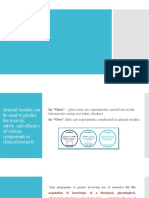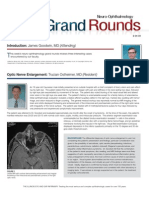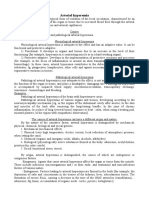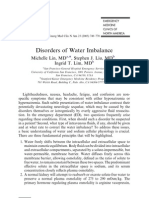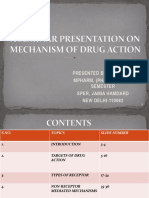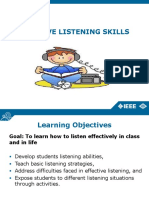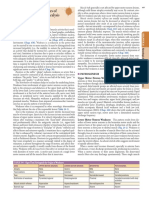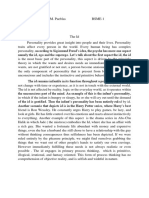3084 C005 PDF
3084 C005 PDF
Uploaded by
מרי וולנטיץCopyright:
Available Formats
3084 C005 PDF
3084 C005 PDF
Uploaded by
מרי וולנטיץOriginal Title
Copyright
Available Formats
Share this document
Did you find this document useful?
Is this content inappropriate?
Copyright:
Available Formats
3084 C005 PDF
3084 C005 PDF
Uploaded by
מרי וולנטיץCopyright:
Available Formats
ANNOTATED BIBLIOGRAPHY
This is a select list of references with some commentary This “classic” textbook by a highly respected author pre-
to help the learner choose additional learning resources sents a detailed description of the nervous system, from
about the structure, function, and diseases of the human the perspective of a neuroanatomist. A more complete
brain. version is also available as a reference text — Carpenter’s
The perspective is for medical students and practitio- Human Neuroanatomy, (1995), now with A. Parent as the
ners not involved with neurology, as well as those in author.
related fields in the allied health professions. The listing
includes texts, atlases, and videotapes, as well as Web sites Fitzgerald, M.J.T. and Folan-Curran, J., Clinical Neuroanatomy
and CD-ROMs. and Related Neuroscience, 4th ed., Saunders, Philadel-
phia, 2002.
TEXTS AND ATLASES The authors have attempted to create an integrated text
for medical and allied health professionals, combining the
This listing includes neuroanatomical textbooks and
basic neuroscience with clinical entities. The book is
atlases, as well as clinical texts; recent publications (since
richly illustrated, in full color, with large appealing
2000) have been preferentially selected.
explanatory diagrams and some MRIs, but there are few
actual photographs. The clinical syndromes are in boxes
NEUROANATOMICAL TEXTS
accompanied by illustrations. A glossary has been added.
Afifi, A.K. and Bergman, R.A., Functional Neuroanatomy Text
Haines, D.E., Fundamental Neuroscience, 2nd ed., Churchill
and Atlas, 2nd ed., Lange Medical Books, McGraw-Hill,
Livingstone, Philadelphia, 2002.
New York, 2005.
This edited large text, with many color illustrations, is an
This is a neuroanatomical text with the addition of func-
excellent reference book, mainly for neuroanatomical
tional information on clinical syndromes. A chapter on the
detail.
normal is followed by a chapter on clinical syndromes
(e.g., of the cerebellum). The book is richly illustrated (in
Kandel, E.R., Schwartz, J.H., and Jessell, T.M., Principles of
two colors) using semi-anatomic diagrams and MRIs. Neural Science, 4th ed., McGraw-Hill, New York, 2000.
Each chapter has key points at the beginning and termi-
nology for that chapter at the end. It is a pleasant book This thorough textbook presents a physiological depiction
visually and quite readable. There is an atlas of the CNS of the nervous system, with experimental details and infor-
at the end, but it’s not in color, and also several brain mation from animal studies. It is suitable as a reference
MRIs. book and for graduate students.
Arslan, O., Neuroanatomical Basis of Clinical Neurology, Par- Kiernan, J.A., Barr’s The Human Nervous System: An Anatom-
thenon Publishing, New York and London, 2001. ical Viewpoint, 8th ed., Lippincott, Williams & Wilkins,
Baltimore, 2005.
A traditional neuroanatomical textbook with many refer-
ences to clinical disease entities (set in blue boxes). The This new edition of Barr’s book is a neuroanatomical
text is nicely formatted, and there are many illustrations, textbook, now with added color, as well as clinical notes
photographs, histological sections, and diagrams (in two (in boxes) and MRIs. It is clearly written, clearly pre-
colors). sented, and includes a glossary. There is an accompanying
CD-ROM with questions and expanded versions of certain
Carpenter, M.B., Core Text of Neuroanatomy, 4th ed., Williams chapters.
and Wilkins, Baltimore, 1991.
239
© 2006 by Taylor & Francis Group, LLC
240 Atlas of Functional Neutoanatomy
Kolb, B. and Whishaw, I.Q., Fundamentals of Human Neurop- NEUROANATOMICAL ATLASES
sychology, 4th ed., W.H. Freeman and Co., New York,
1996. DeArmond, S.J., Fusco, M.M., and Dewey, M.M., Structure of
the Human Brain: A Photographic Atlas, 3rd ed., Oxford
A classic in the field and highly recommended for a good University Press, Oxford, 1989.
understanding of the human brain in action. Topics dis-
cussed include memory, attention, language, and the lim- An excellent and classic reference to the neuroanatomy
bic system. of the human CNS. No explanatory text and no color.
Martin, J.H., Neuroanatomy: Text and Atlas, 3rd ed., McGraw- England, M.A. and Wakely, J., Color Atlas of the Brain and
Hill, New York. 2003. Spinal Cord, Mosby, St. Louis, 1991.
A very complete text with a neuroanatomical perspective A very well illustrated atlas, with most of the photographs
and accompanied by some fine (two-color) explanatory and sections in color. Little in the way of explanatory text.
illustrations, written as the companion to Kandel et al. The
material is clearly presented, with explanations of how Felten, D.L. and Jozefowicz, R.F., Netter’s Atlas of Human Neu-
systems function. A detailed atlas section is included at roscience, Icon Learning Systems, Teterboro, NJ, 2003.
the end, as well as a glossary of terms.
The familiar illustrations of Netter on the nervous system
Nolte, J., The Human Brain, 5th ed., Mosby, St. Louis, 2002. have been collected into a single atlas, each with limited
commentary. Both peripheral and autonomic nervous sys-
This is a new edition of an excellent neuroscience text, tems are included. The diagrams are extensively labeled.
with anatomical and functional (physiological) informa-
tion on the nervous system, complemented with clinically Haines, D., Neuroanatomy: An Atlas of Structures, Sections and
relevant material. The textbook includes scores of illus- Systems, 6th ed., Lippincott, Williams and Wilkins, Bal-
trations in full color, stained brainstem and spinal cord timore, 2004.
cross-sections, along with three-dimensional brain recon-
structions by John Sundsten. A glossary has been added. A popular atlas that has some excellent photographs of
the brain, some color illustrations of the vascular supply,
Steward, O., Functional Neuroscience, Springer, Berlin, 2000. with additional radiologic material, all without explana-
tory text. The histological section of the brainstem is very
According to the author, this is a book for medical students detailed. There is a limited presentation of the pathways
that blends the physiological systems approach with the and functional systems, with text. This edition comes with
structural aspects. The emphasis is on the “processing” of a CD-ROM containing all the illustrations, with some
information, for example, in the visual system. Chapters accompanying text.
at the end discuss arousal, attention, consciousness, and
sleep. It is nicely formatted and readable. Netter, F.H., The CIBA Collection of Medical Illustrations, Vol-
ume 1, Part 1, CIBA, Summit, NJ, 1983.
Williams, P. and Warwick, R., Functional Neuroanatomy of Man,
W.B. Saunders, Philadelphia, 1975. A classic. Excellent illustrations of the nervous system,
as well as of the skull, the autonomic and peripheral ner-
This is the “neuro” section from Gray’s Anatomy. vous systems, and embryology. The text is interesting but
Although somewhat dated, there is excellent reference may be dated.
material on the central nervous system, as well as the
nerves and autonomic parts of the peripheral nervous sys- Nieuwenhuys, R., Voogd, J., and van Huijzen, C., The Human
tem. The limbic system and its development are also well Central Nervous System, Springer Verlag, Berlin, 1981.
described.
Unique three-dimensional drawings of the CNS and its
pathways are presented, in tones of gray. These diagrams
Wilson-Pauwels, L., Akesson, E.J., and Stewart, P.A., Cranial are extensively labeled, with no explanatory text.
Nerves: Anatomy and Clinical Comments, B.C. Decker,
Toronto, 1988. Nolte, J. and Angevine, J.B., The Human Brain in Photographs
and Diagrams, 2nd ed., Mosby, St. Louis, 2000.
A handy resource on the cranial nerves, with some very
nice illustrations. It is relatively complete and easy to A well illustrated (color) atlas, with text and illustrations,
follow. and neuroradiology. Functional systems are drawn onto
© 2006 by Taylor & Francis Group, LLC
Annotated Bibliography 241
the brain sections with the emphasis on the neuroanatomy; Harrison’s is a trusted, authoritative source of information,
the accompanying text is quite detailed. Excellent three- with few illustrations. Part 2 in Section 3 (Volume I) has
dimensional brain reconstructions by J.W. Sundsten. chapters on the presentation of disease; Part 15 (Volume
II) is on all neurologic disorders of the CNS, nerve and
Woolsey, T.A., Hanaway, J., and Gado, M.H., The Brain Atlas: muscle diseases, as well as mental disorders. The online
A Visual Guide to the Human Central Nervous System, version of Harrison’s has updates, search capability, prac-
2nd ed., Wiley, Hoboken, NJ, 2003. tice guidelines, and online lectures and reviews, as well
as illustrations.
Part II of the book is a complete pictorial atlas of the
human brain, with some color illustrations and radio- Ropper, A.H. and Brown, R.H., Adams and Victor’s Principles
graphic material. Parts III and IV consist of histological of Neurology, 8th ed., McGraw-Hill, New York, 2005.
sections of the hemispheres, brainstem, spinal cord, and
limbic structures. Part V presents the pathways, accompa- A comprehensive neurology text — with part devoted to
nied by some explanatory text. cardinal manifestations of neurologic diseases and part to
major categories of diseases.
CLINICAL TEXTS
Rowland, J.P., Merritt’s Neurology, 11th ed., Lippincott, Will-
Aminoff, M.J., Greenberg, D.A., and Simon, R.P., Clinical Neu- iams and Wilkins, Baltimore, 2005.
rology, 6th ed., Lange Medical Books/McGraw-Hill,
New York, 2005. A well-known, complete, and trustworthy neurology text-
book, now edited by L.P. Rowland.
If a student wishes to consult a clinical book for a quick
look at a disease or syndrome, then this is a suitable book Royden-Jones, H., Netter’s Neurology, Icon Learning Systems,
of the survey type. Clinical findings are given, and inves- Teterboro, NJ, 2005.
tigative studies are included, as well as treatment. The
illustrations are adequate (in two colors), and there are Netter’s neurological illustrations have been collected in
many tables with classifications and causes. one textbook, with the addition of Netter-style clinical
pictures; these add an interesting dimension to the descrip-
Asbury, A.K., McKhann, G.M., McDonald, W.I., Goodsby, P.J., tive text. There is broad coverage of many disease states,
and McArthur, J.C., Diseases of the Nervous System: though not in depth, with clinical scenarios in each chap-
Clinical Neurobiology, 3rd ed., Cambridge University ter. It is now available with a CD-ROM.
Press, Cambridge, 2002.
PEDIATRIC NEUROLOGY
A complete neurology text, in two volumes, on all aspects
of basic and clinical neurology and the therapeutic Fenichel, G.M., Clinical Pediatric Neurology, W. B. Saunders,
approach to diseases of the nervous system. Philadelphia, 2001.
Donaghy, M., Brain’s Disease of the Nervous System, 11th ed., This book is recommended for medical students and other
Oxford University Press, Oxford, 2001. novices by a highly experienced pediatric neurologist as
a basic text with a clinical approach, using signs and
A very trusted source of information about clinical dis- symptoms.
eases and their treatments.
NEUROPATHOLOGY
Fuller, G. and Manford, M., Neurology: An Illustrated Colour
Text, Churchill Livingstone, London, 2000. Robbin’s Neuropathology
A concise explanation of select clinical entities is pre- Robbins and Cotran Pathologic Basis of Disease, 7th ed., Kumar,
sented, with many illustrations (in full color); not a com- V., Abbas, A.K., and Fausto, N., Eds, Elsevier Saunders,
prehensive textbook. The large format and presentation Philadelphia, 2005.
make this an appealing but limited book.
A complete source for information on all aspects of
Harrison’s Principles of Internal Medicine, 16th ed., Kasper, pathology for learners, including neuropathology. Pur-
D.L., Braunwald, E., Fauci, A.S., Hauser, S.L., Longo, chase of the book includes a CD-ROM with interactive
D.L., and Jameson, J.L., Eds, McGraw-Hill, New York, clinical cases, and access to the Web site.
2005.
© 2006 by Taylor & Francis Group, LLC
242 Atlas of Functional Neutoanatomy
Robbins Basic Pathology, 7th ed., Kumar, V., Cotran, R.S., and Brain Facts
Robbins, S.L., Eds, Saunders, Philadelphia, 2003.
Brain Facts is a 52-page primer on the brain and nervous
Not as complete as the other text (above). system, published by the Society for Neuroscience. It is a
starting point for a general audience interested in
neuroscience. This newly revised edition of Brain Facts is
WEB SITES available in print and in pdf format. The new edition
updates all sections and includes new information on
Web sites should only be recommended to students after brain development, addiction, neurological and
they have been critically evaluated by the teaching faculty. psychiatric illnesses, and potential therapies.
If keeping up with various teaching texts is difficult, a
critical evaluation of the various Web resources is an DIGITAL ANATOMIST PROJECT
impossible task for any one person. This is indeed a task
http://www9.biostr.washington.edu/da.html
to be shared with colleagues, and perhaps by a consortium
Brain Atlas: The material includes two-dimensional and
of teachers and students.
three-dimensional views of the brain from cadaver sec-
Additional sources of reliable information on diseases
tions, MRI scans, and computer reconstructions. Authored
are usually available on the disease-specific Web site
by John W. Sundsten.
maintained by an organization, usually with clear explan-
Neuroanatomy Interactive Syllabus: This syllabus
atory text on the disease and often accompanied by excel-
lent illustrations. uses the images in the Atlas (above) and many others. It
is organized into functional chapters suitable as a labora-
The following sites have been visited by the author,
tory guide, with an instructive caption accompanying each
and several of them are gateways to other sites — clearly
image. It contains three-dimensional computer graphic
not every one of the links has been viewed. Although some
reconstructions of brain material; MRI scans; tissue sec-
are intended for the general public, they may contain good
tions, some enhanced with pathways; gross brain speci-
illustrations or other links.
mens and dissections; and summary drawings. Chapters
The usual www precaution prevails — look carefully
include Topography and Development, Vessels and Ven-
at who created the Web site and when.
tricles, Spinal Cord, Brainstem and Cranial Nerves, Sen-
One additional piece of advice — a high-speed con-
sory and Motor Systems, Cerebellum and Basal Ganglia,
nection is a must for this exploration.
Eye Movements, Hypothalamus and Limbic System, Cor-
tical Connections, and Forebrain and MRI Scan Serial
SOCIETY FOR NEUROSCIENCE
Sections. Authored by John W. Sundsten and Kathleen A.
http://web.sfn.org/ Mulligan.
This is the official Web site for the Society for Neuro- Institution: Digital Anatomist Project, Department of
science, a very large and vibrant organization with an Biological Structure, University of Washington, Seattle.
annual meeting attended by more than 30,000 neurosci- Atlas was formerly available on CD-ROM (JAVA pro-
entists from all over the world. gram running on Mac and PC platform).
The Society maintains an active educational branch,
which is responsible for sponsoring a Brain Awareness BRAINSOURCE
Week aimed at the public at large and, particularly, at
http://www.brainsource.com/
students in elementary and high schools. The following
BrainSource is an informational Web site aimed at enrich-
are examples of their publications.
ing professional, practical, and responsible applications of
neuropsychological and neuroscientific knowledge. The
Searching for Answers: Families and Brain
Web site is presented by neuropsychologist Dennis P.
Disorders
Swiercinsky.
This four-part DVD shows the human face of degenerative The site includes a broad and growing collection of
brain diseases. Researchers tell how they are working to information and resources about normal and injured
find treatments and cures for Huntington’'s disease, Par- brains, clinical and forensic neuropsychology, brain injury
kinson’s disease, amyotrophic lateral sclerosis (ALS), and rehabilitation, creativity, memory and other brain pro-
Alzheimer’s disease. Patients and families describe the cesses, education, brain-body health, and other topics in
powerful physical, emotional, and financial impact of brain science. BrainSource is also a guide to products,
these devastating disorders. books, continuing education, and Internet resources in
neuroscience.
This Web site originated in 1998 for promotion of
clinical services and as a portal for dissemination of cer-
tain documents useful for attorneys, insurance profession-
© 2006 by Taylor & Francis Group, LLC
Annotated Bibliography 243
als, students, families and persons with brain injury, reha- subtopic covered on this site, you can choose from three
bilitation specialists, and others working in the field of different levels of explanation — beginner, intermediate,
brain injury. The Web site is growing to expand content or advanced. The major topics include anatomy and func-
to broader areas of neuropsychological application. tion, memory, sensory and motor systems, pain and plea-
sure, emotion, evolution; other subject areas are under
DISEASES AND DISORDERS development.
This site focuses on five major levels of organization
http://www.mic.ki.se/Diseases/C10.html
— social, psychological, neurological, cellular, and
This site was created by the Karolinska Institute Univer- molecular. On each page of this site, you can click to move
sity Library and contains links pertaining to Nervous Sys- among these five levels and learn what role each plays in
tem Diseases. It is a convenient starting point for all the subject under discussion.
sources of information about the brain. Not all the sites
are necessarily scientifically certified.
THE NEUROLOGIC EXAM — ONLINE
NEUROANATOMY AND NEUROPATHOLOGY ON THE http://medstat.med.utah.edu/neurologicexam/home_exam.html
INTERNET This includes both an adult and pediatric neurological
examination, with video and sound. In addition, there are
http://www.neuropat.dote.hu four neurologic cases on this site, with possibly more to
This site has been compiled and designed by Katalin come.
Hegedus, Department of Neurology, University of Debre-
cen, Hungary. It is a source for other sites including neu- THE DANA FOUNDATION
roanatomy, neuropathology, and neuroradiology, and soft-
ware (commercial and noncommercial) on the brain, and http://www.dana.org/
even includes quizzes. The Dana Foundation is a private philanthropic organiza-
tion with a special interest in brain science, immunology,
HARDIN MD and arts education. It was founded in 1950.
The Dana Alliance is a nonprofit organization of more
http://www.lib.uiowa.edu/hardin/md/neuro.html than 200 pre-eminent scientists dedicated to advancing
This site is a service of the Hardin Library for Health education about the progress and promise of brain
Sciences, University of Iowa. Hardin MD was first research.
launched in 1996 as a source to find the best lists, or The Brain Center of this site is a gateway to the latest
directories, of information in health and medicine. The research on the human brain. The Brain Information and
name Hardin MD comes from Hardin Meta Directory, Brain Web sections access links to validated sites related
since the site was conceived as a “directory of directories.” to more than 25 brain disorders.
Providing links to high quality directory pages is still an
important part of Hardin MD. In recent years, however, NEUROSCIENCE FOR KIDS
they have added other types of links: Just Plain Links
pages have direct links to primary information in circum- http://faculty.washington.edu/chudler/neurok.html
scribed subjects, and many of their pages have links to Neuroscience for Kids was created for all students and
medical pictures. teachers who would like to learn about the nervous system.
The site contains a wide variety of resources, including
SPECIFIC SITES images — not only for kids. Sections include exploring
the brain, Internet neuroscience resources, neuroscience
• Loyola University, Chicago, Stritch School of in the news, and reference to books, magazines articles,
Medicine and newspaper articles about the brain.
http://www.meddean.luc.edu/lumen/Med- Neuroscience for Kids is maintained by Eric H.
Ed/Neuro/index.htm Chudler and supported by a Science Education Partnership
• Harvard, The Whole Brain Imaging Atlas Award (R25 RR12312) from the National Center for
http://www.med.harvard.edu/AAN- Research Resources.
LIB/home.html
TELEVISION SERIES
THE BRAIN FROM TOP TO BOTTOM http://www.pbs.org/wnet/brain/index.html
http://www.thebrain.mcgill.ca/flash/index_d.html The Secret Life of the Brain, a David Grubin Production,
This site is designed to let users choose the content that reveals the fascinating processes involved in brain devel-
matches their level of knowledge. For every topic and opment across a lifetime. This five-part series, which was
© 2006 by Taylor & Francis Group, LLC
244 Atlas of Functional Neutoanatomy
shown nationally on PBS in the winter of 2002, informs the cranial nerves and a functional presenta-
viewers of exciting new information in the brain sciences, tion of the cerebellum.
introduces the foremost researchers in the field, and uti- Part III: Cerebrovascular System and Cerebrospi-
lizes dynamic visual imagery and compelling human sto- nal Fluid
ries to help a general audience understand otherwise dif- A presentation of these two subjects.
ficult scientific concepts. Part IV: The Limbic System
The material includes History of the Brain, 3-D Brain A quite detailed presentation on the various as-
Anatomy, Mind Illusions, and Scanning the Brain. Epi- pects of the limbic system, with much expla-
sodes include: The Baby’s Brain, The Child’s Brain, The nation and special dissections.
Teenage Brain, The Adult Brain, The Aging Brain.
The Secret Life of the Brain is a co-production of NOTE: It is suggested that these videotapes be pur-
Thirteen/WNET New York and David Grubin Produc- chased by the library or by an institutional (or departmen-
tions, © 2001 Educational Broadcasting Corporation and tal) media or instructional resource center.
David Grubin Productions, Inc. Information regarding the purchase of these and other
videotapes may be obtained from: Health Sciences Con-
sortium, 201 Silver Cedar Ct., Chapel Hill, NC, 27514-
VIDEOTAPES (BY THE AUTHOR) 1517. Phone: (919) 942-8731. Fax: (919) 942-3689.
These edited videotape presentations are on the skull and
the brain as the material would be shown to students in CD-ROMS
the gross anatomy laboratory. They have been prepared
with the same teaching orientation as this atlas and are Numerous CDs are appearing on the market, and their
particularly useful for self-study or small groups. These evaluation by the teaching faculty is critical before rec-
videotapes of actual specimens are particularly useful for ommending them to learners. In addition, several of the
students who have limited or no access to brain specimens. newer textbooks and atlases now have an accompanying
The videotapes are fully narrated and each lasts for about CD-ROM. It is indeed a difficult task to obtain and review
20–25 minutes. all the CDs now available and perhaps one that can be
The videotapes are handled by Health Sciences Con- shared with students after they have completed their pro-
sortium, a non-profit publishing cooperative for instruc- gram of study on the nervous system.
tional media. They may now be requested in DVD format. A listing of the CD-ROMs available can be viewed
on the Web site Neuroanatomy and Neuropathology on
INTERIOR OF THE SKULL the Internet (above) — see http://www.neuro-
pat.dote.hu/software.htm.
This program includes a detailed look at the bones of the
skull, the cranial fossa, and the various foramina for the The following has been reviewed:
cranial nerves and other structures. Included are views of
the meninges and venous sinuses. Brainstorm: Interactive Neuroanatomy
By Gary Coppa and Elizabeth Tancred, Stan-
THE GROSS ANATOMY OF THE HUMAN BRAIN SERIES ford University
A highly interactive and well-integrated cross-
Part I: The Hemispheres linked presentation of the anatomy and some
A presentation on the hemispheres, the func- functional aspects of the nervous system.
tional areas of the cerebral cortex, including Published by Mosby, 11830 Westline Industrial
the basal ganglia. Drive, P.O. BOX 46908, St. Louis, MO,
Part II: Diencephalon, Brainstem, and Cerebellum 63146-9934.
A detailed look at the brainstem, with a focus on
© 2006 by Taylor & Francis Group, LLC
You might also like
- How To Make Your Own KippahDocument2 pagesHow To Make Your Own Kippahמרי וולנטיץ100% (6)
- Preview Compendium Medicine Pocket Obstetrics and GynaecologyDocument18 pagesPreview Compendium Medicine Pocket Obstetrics and GynaecologyMerinz Meri100% (1)
- Tips and Advice To Pass The Psychometrician Board ExamDocument19 pagesTips and Advice To Pass The Psychometrician Board ExamhamidalhadieNo ratings yet
- Basic Immunology Functions and Disorders of Immune System PDFDocument3 pagesBasic Immunology Functions and Disorders of Immune System PDFMusa TadzNo ratings yet
- How To Make Your Own KipahDocument4 pagesHow To Make Your Own Kipahמרי וולנטיץ100% (2)
- AtaxiaDocument19 pagesAtaxiaHenry DanielNo ratings yet
- The Folate PathwayDocument3 pagesThe Folate PathwaySNo ratings yet
- Cranial Nerves: in Health and DiseaseDocument2 pagesCranial Nerves: in Health and DiseasePierre PradelNo ratings yet
- Inflammatory and Autoimmune Disorders of the Nervous System in ChildrenFrom EverandInflammatory and Autoimmune Disorders of the Nervous System in ChildrenNo ratings yet
- VETS6208 Principles of Animal Diseases: Cardiorespiratory Pathology NotesDocument66 pagesVETS6208 Principles of Animal Diseases: Cardiorespiratory Pathology NotesCeline BerjotNo ratings yet
- Duus'Document344 pagesDuus'ulyaamaliaNo ratings yet
- Pharaoh in Canaan Daphna Ben-TorDocument92 pagesPharaoh in Canaan Daphna Ben-Torמרי וולנטיץ100% (2)
- Ancient Hebrew DictionaryDocument206 pagesAncient Hebrew DictionaryAlex Oc100% (3)
- 16PF Profile ReportDocument6 pages16PF Profile Reportvbhard0% (1)
- Teaching Language To Children With Autism &/or Developmental DisordersDocument3 pagesTeaching Language To Children With Autism &/or Developmental DisordersMark Gatmaitan0% (1)
- Neurology Study Guide Oral Board Exam ReviewDocument1 pageNeurology Study Guide Oral Board Exam Reviewxmc5505No ratings yet
- Dopaminergic and Serotonergic Neurohumoural TransmissionDocument23 pagesDopaminergic and Serotonergic Neurohumoural TransmissionChaitanya Kiran PullelaNo ratings yet
- Cannabinoid Receptor Pharmacology: The Endocannabinoid SystemDocument22 pagesCannabinoid Receptor Pharmacology: The Endocannabinoid Systemdaniel_jose_skateNo ratings yet
- Preclinical PDFDocument36 pagesPreclinical PDFxyzNo ratings yet
- Spinal Regeneration AricleDocument5 pagesSpinal Regeneration Aricledts5053No ratings yet
- 2019 - 08 - 05 Essential TremorDocument16 pages2019 - 08 - 05 Essential TremorstaseaditNo ratings yet
- Movement Disorders EmergenciesDocument12 pagesMovement Disorders EmergenciesAnonymous QLadTClydkNo ratings yet
- Paxinos The Rat Brain 60 PDFDocument1 pagePaxinos The Rat Brain 60 PDFjoseuri2011No ratings yet
- MBBS 1st Year 2023Document2 pagesMBBS 1st Year 2023Sreejith NairNo ratings yet
- New Therapies For Neuromyelitis Optica Spectrum DisorderDocument8 pagesNew Therapies For Neuromyelitis Optica Spectrum DisorderCosmin SandulescuNo ratings yet
- Animal Models in Disease Research: Honours Department of Pathology University of Melbourne Theo MantamadiotisDocument35 pagesAnimal Models in Disease Research: Honours Department of Pathology University of Melbourne Theo MantamadiotisRiv sashNo ratings yet
- A Serum Autoantibody Marker of Neuromyelitis Optica: Distinction From Multiple SclerosisDocument7 pagesA Serum Autoantibody Marker of Neuromyelitis Optica: Distinction From Multiple SclerosistiaraleshaNo ratings yet
- Crab - Nervous SystemDocument10 pagesCrab - Nervous SystemKim Esperas SitchonNo ratings yet
- Test Neurologia y Enfermedades SistemicasDocument9 pagesTest Neurologia y Enfermedades SistemicasJuliana AparcanaNo ratings yet
- Translation DisordersDocument14 pagesTranslation DisordersProfessor Rakesh Sharma Biochemistry Lectures100% (1)
- PICO and Critical Appraisal - Ketogenic Diet For Epilepsy in Children - Part 1. ValidityDocument15 pagesPICO and Critical Appraisal - Ketogenic Diet For Epilepsy in Children - Part 1. Validityelizabeth salimNo ratings yet
- Instant ebooks textbook USMLE Step 1 Lecture Notes 2020: 7-Book Set 1st Edition Kaplan Medical download all chaptersDocument52 pagesInstant ebooks textbook USMLE Step 1 Lecture Notes 2020: 7-Book Set 1st Edition Kaplan Medical download all chapterscoronshadia6100% (1)
- Get Critical Care EEG Basics-Rapid Bedside EEG Reading for Acute Care Providers (Feb 29, 2024)_(1009261169)_(Cambridge University Press) Jadeja free all chaptersDocument47 pagesGet Critical Care EEG Basics-Rapid Bedside EEG Reading for Acute Care Providers (Feb 29, 2024)_(1009261169)_(Cambridge University Press) Jadeja free all chapterskosmakort100% (1)
- Artigo de Rita CharonDocument6 pagesArtigo de Rita CharonLemuel DinizNo ratings yet
- FA 2020 - Cardio EmbryoDocument7 pagesFA 2020 - Cardio EmbryoDrbee10No ratings yet
- 100 Questions Micro-Gross HSBDocument9 pages100 Questions Micro-Gross HSBfilchibuffNo ratings yet
- Neuro-Ophthalmology: Introduction: James Goodwin, MD (Attending)Document4 pagesNeuro-Ophthalmology: Introduction: James Goodwin, MD (Attending)Mariano FioreNo ratings yet
- The Neurobiology of Abnormal Manifestations of AggressionDocument13 pagesThe Neurobiology of Abnormal Manifestations of AggressionfernandogfcnsNo ratings yet
- Introduction To PathologyDocument14 pagesIntroduction To PathologyAlfred ChowNo ratings yet
- Νευρολογία σύνολο απαντήσεωνDocument38 pagesΝευρολογία σύνολο απαντήσεωνCheng Kuao HengNo ratings yet
- Misra U, Kalita J Dan Dubey D. A Study of Super Refractory Status Epilepticus From IndiaDocument10 pagesMisra U, Kalita J Dan Dubey D. A Study of Super Refractory Status Epilepticus From IndiasitialimahNo ratings yet
- Anticonvulsants 2Document1 pageAnticonvulsants 2Taif Salim100% (1)
- 01-Wk1 - (05 - 10 - 06) LECTURE 1 - STRUCTURE AND FUNCTION OF THE BRAIN-1160379353Document26 pages01-Wk1 - (05 - 10 - 06) LECTURE 1 - STRUCTURE AND FUNCTION OF THE BRAIN-1160379353Red Fool100% (1)
- 1 - Spinal Cord NotesDocument7 pages1 - Spinal Cord NotesOceanChan QdNo ratings yet
- The New Clasification ILAE 2017Document6 pagesThe New Clasification ILAE 2017Ami D ALNo ratings yet
- Physiochemical Basis of Clinical Medicine Biochemistry ApproachDocument12 pagesPhysiochemical Basis of Clinical Medicine Biochemistry ApproachProfessor Rakesh Sharma Biochemistry LecturesNo ratings yet
- Exam NeurologyDocument4 pagesExam Neurologyabdulwasa almogahedNo ratings yet
- Jasper's Basic Mechanisms of The EpilepsiesDocument1,733 pagesJasper's Basic Mechanisms of The Epilepsiescamila raianna justiniana rochaNo ratings yet
- Conducting A Nurse Consultation: ClinicalDocument6 pagesConducting A Nurse Consultation: ClinicalAlif Akbar HasyimiNo ratings yet
- Inkijkexemplaar Neurology V02Document15 pagesInkijkexemplaar Neurology V02vickykushwaha618No ratings yet
- Microbiota-Gut-Brain Axis Mechanisms in The Complex Network PDFDocument29 pagesMicrobiota-Gut-Brain Axis Mechanisms in The Complex Network PDFbenqtenNo ratings yet
- Traditional Acid-Base Analysis: Kate HopperDocument7 pagesTraditional Acid-Base Analysis: Kate HopperJeaneth SamaniegoNo ratings yet
- 49 Neural Regulation in Animals-2018 PDFDocument61 pages49 Neural Regulation in Animals-2018 PDFlaw0516No ratings yet
- Histology of Endocrine GlandsDocument36 pagesHistology of Endocrine GlandsDaiva ŠiaulienėNo ratings yet
- Neuropharmacology of Antiepileptic Drugs: P-Slide 1Document64 pagesNeuropharmacology of Antiepileptic Drugs: P-Slide 1Hasnain AbbasNo ratings yet
- Arterial HyperemyDocument10 pagesArterial HyperemyRohit NaiduNo ratings yet
- Neurology: Timothy E. Welty, Pharm.D., FCCP, BCPSDocument68 pagesNeurology: Timothy E. Welty, Pharm.D., FCCP, BCPSAlmaha AlfakhriNo ratings yet
- Disorders of Water ImbalanceDocument22 pagesDisorders of Water ImbalanceRLauncherNo ratings yet
- History Taking in Nervous SystemDocument18 pagesHistory Taking in Nervous Systemdrvinodg2000No ratings yet
- A Seminar Presentation On Mechanism of Drug ActionDocument40 pagesA Seminar Presentation On Mechanism of Drug Actionbellatrix aliaNo ratings yet
- Summary ImmunologyDocument1 pageSummary ImmunologyNoor AlsheikhNo ratings yet
- Lippincott Illustrated Reviews Neuroscience 2e 13Document25 pagesLippincott Illustrated Reviews Neuroscience 2e 13hai ha100% (1)
- Kalaazar MX Guideline 22.06.2015Document100 pagesKalaazar MX Guideline 22.06.2015Child HealersNo ratings yet
- BTS Guidelines For Emergency Oxygen Use in Adults PatiensDocument81 pagesBTS Guidelines For Emergency Oxygen Use in Adults PatiensarmitadewiNo ratings yet
- Booklist For MedDocument16 pagesBooklist For Medngc1100% (1)
- Neuroimaging in DementiaDocument11 pagesNeuroimaging in DementiaAndika ResaNo ratings yet
- 02 סיפורים לקטנטנים מאגדות האחים גרים PDFDocument78 pages02 סיפורים לקטנטנים מאגדות האחים גרים PDFמרי וולנטיץNo ratings yet
- Yiddish Jezik - KnjigaDocument102 pagesYiddish Jezik - Knjigaמרי וולנטיץNo ratings yet
- Psikofarmakoloji Ders Notları 1Document13 pagesPsikofarmakoloji Ders Notları 1libreizanNo ratings yet
- MBDDocument4 pagesMBDyvesdrewNo ratings yet
- Defense Mechanisms 40 Years of Empirical ResearchDocument11 pagesDefense Mechanisms 40 Years of Empirical ResearchClaudia Rodón Fonte0% (1)
- Periodization of Psychological PreparationDocument20 pagesPeriodization of Psychological PreparationAlina Anghel100% (1)
- Bullying: Description and Analysis of The Phenomenon: Juan Luís Benítez Fernando JusticiaDocument20 pagesBullying: Description and Analysis of The Phenomenon: Juan Luís Benítez Fernando JusticiariniNo ratings yet
- RRL Reflective WritingDocument6 pagesRRL Reflective Writingmain.15001068No ratings yet
- Practicing College Learning Strategies Fifth Edition Carolyn H. Hopper All Chapters Instant DownloadDocument71 pagesPracticing College Learning Strategies Fifth Edition Carolyn H. Hopper All Chapters Instant Downloadyuealfek100% (6)
- ImaginatiaDocument13 pagesImaginatiaAndrutza AndraNo ratings yet
- Effective ListeningDocument31 pagesEffective ListeningMuhammad Ilham ZulkipllyNo ratings yet
- Tutor Neurological Examination ..Pocket Tutor.. 2nd Edition 2017 PDFDocument216 pagesTutor Neurological Examination ..Pocket Tutor.. 2nd Edition 2017 PDFsun sealNo ratings yet
- Functional Approaches Eng MajDocument4 pagesFunctional Approaches Eng Maj7vh4crcs5gNo ratings yet
- Muscles and WeaknessDocument9 pagesMuscles and WeaknessFray BotodNo ratings yet
- Deep Learning KCS078Document2 pagesDeep Learning KCS078xefedoy5330% (1)
- Organization Behavior: MBA Integrated I SemDocument36 pagesOrganization Behavior: MBA Integrated I Sems_87045489No ratings yet
- 48 Electrical Signals in Animals-2018 PDFDocument56 pages48 Electrical Signals in Animals-2018 PDFlaw0516No ratings yet
- Child and Adolescent Development MultiplDocument13 pagesChild and Adolescent Development MultiplHannah Coleen AndradaNo ratings yet
- Language Abnormalities in SchizophreniaDocument12 pagesLanguage Abnormalities in SchizophreniaAndres DiazNo ratings yet
- A Novel Multigene Family May Encode Odorant Receptors: A Molecular Basis For Odor RecognitionDocument13 pagesA Novel Multigene Family May Encode Odorant Receptors: A Molecular Basis For Odor RecognitionBảo Hoàng DươngNo ratings yet
- The Life Cycle of A Butterfly Writing ActivityDocument3 pagesThe Life Cycle of A Butterfly Writing Activityapi-381659399No ratings yet
- Assessment To Lesson 3Document5 pagesAssessment To Lesson 3jembertbajan21No ratings yet
- Daftar Pustaka Responsi BsDocument2 pagesDaftar Pustaka Responsi BsghaziaNo ratings yet
- STS Freud TheoryDocument3 pagesSTS Freud TheoryChris Thel MayNo ratings yet
- Egils Kipste Thesis Part B PDFDocument249 pagesEgils Kipste Thesis Part B PDFMauricio Quevedo PintoNo ratings yet
- Critique Group 5: Role of Humour in The Life of Urban MillennialsDocument6 pagesCritique Group 5: Role of Humour in The Life of Urban MillennialsRose FlowerNo ratings yet
- Cognitive-Behavioral Case Formulation and Treatment Plan ExampleDocument8 pagesCognitive-Behavioral Case Formulation and Treatment Plan ExampleJohari AwangNo ratings yet
- Lesson Plan - Numbers 1-10 (3º Ano)Document3 pagesLesson Plan - Numbers 1-10 (3º Ano)Jéssica FernandesNo ratings yet
- PDFDocument19 pagesPDFAlison MoklaNo ratings yet


















